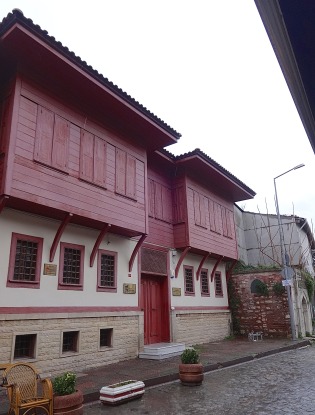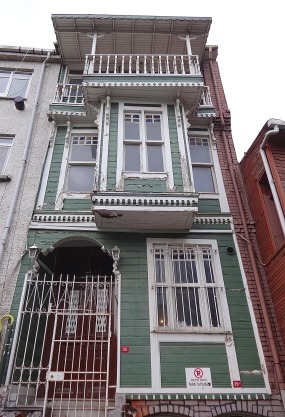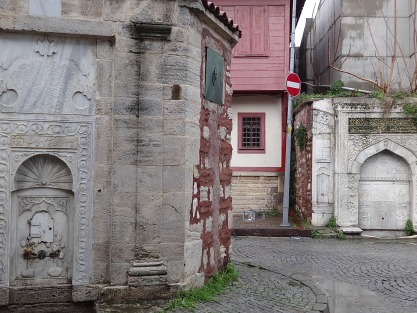“Life-Saver”
Market: Wednesday (beside Sphendone)
Many hotels in İstanbul which are labelled as being in Sultanahmet are technically in the neighbourhood called Cankurtaran which runs down from behind Ayasofya Meydanı to the shores of the Sea of Marmara. Its throbbing heart is the street called Akbıyık Caddesi (White Moustache St) which is lined with hotels, hostels, bars, restaurants and shops aimed at tourists. It used to have a rather ramshackle atmosphere that might have put some world travellers in mind of Thailand’s famous Khao San Road but these days it – like the rest of the area – is moving relentlessly upmarket.
While gentrification is ripping through the area there are still many back streets where old wooden houses are still just about hanging on if often at precarious angles.
Around Cankurtaran
This is an area of minor monuments rather than great treasures although they are nonetheless well worth seeing. Right on Aybıyık Caddesi, for example, the İşhakpasa Cami, stuck on a corner behind a high wall and missed by most visitors in their rush to reach Topkapı Sarayı, was built in 1482, making it one of the oldest mosques in the city and designed in a style more common in Bursa. Across the road the remains of a contemporary hamam are slated for development.
A relic of the Byzantine Great Palace can be viewed by diners at the Paladium Restaurant in Kutlugün Sokak and at the Albura Kathisma Restaurant in Akbıyık Caddesi. This mysterious stretch of domed halls and passages is believed to have served as a covered corridor inside the palace. Its excavation was a labour of love undertaken by the owner of the Paladium. Further along Akbıyık Caddesi there is another small section of wall from the Magnaura Palace which formed part of the Great Palace.

The wooden house of Dede Efendi is open to the public as a small museum of musical instruments. Hamamizade İsmail Dede Efendi (1778-1846) was a famous composer of Ottoman classical music. It sits in a pretty part of the neighbourhood with two elegant 18th-century çeşmes (fountains).
If you walk down from Küçük Ayasofya Caddesi to Kennedy Caddesi (the main sea road) you will come to the remains of the Byzantine Propontine Sea Walls that ran all the way from the Marble Tower (Mermer Kule) at Yedikule in the west to Ayvansaray in the east. Despite the heavy traffic along this road, you can walk from either of the old city gates, Ahırkapı (Stable Gate) or Çatladıkapı (Cracked Gate), to Sarayburnu in half an hour, passing two important but often overlooked landmarks as you go.
The first is the support wall that is all that remains of the marble İncili Köşk (Pearl Pavilion), built into the perimeter wall of Topkapı Palace in 1591 by the grand vizier, Sinan Paşa, and once one of four such kiosks (only the Sepetçiler Pavilion at Sirkeci still survives intact). It was designed by architect Davud Ağa and named after the pearls decorating its dome. In his old age Sultan Murad III (r. 1574-95) is said to have been listening to music while gazing out to sea from this pavilion when the passing navy fired their guns in his honour, thereby creating vibrations that caused part of the ceiling to collapse on him. The Pearl Pavilion was also the last known resting place of a famous organ sent as a gift to Sultan Mehmed III by Queen Elizabeth I of England; it features in Katie Hickman’s novel, The Aviary Gate.
Greek pilgrims visited the ayazma (sacred spring) of Hagios Sotiros beneath the İnçili Köşk into the 19th century. Restored in the reign of Sultan Mahmut II, it was abandoned in 1856. In 2024 it was being restored once again.
Just past the pavilion, patterns in the brickwork of the wall and the shapes of arches and windows are all that remain of the 12th-century Church of Saviour Philanthropos (Jesus the Charitable). This used to be a popular destination for medieval pilgrims from Russia who reported a miracle-working statue there.
Eating
Albura Kathisma on Akbıyık Caddesi not only offers excellent service but also has a much wider choice of options for vegetarian diners than is usual. Tel: 0212-518 9710
The glory days when it was patronised by the likes of flamboyant singer Zeki Muren may be behind it, but it’s been in the meyhane business since 1938 so Karışma Sen (which means “don’t get involved”) must be doing something right. The location, right on the busy coast road, probably explains why it’s better known to locals than visitors. Tel: 0212-458 0081
Sleeping
Best Western Citadel Hotel. Tel: 0212-516 2313
Dersaadet Hotel. Tel: 0212-458 0768
Emine Sultan Hotel. Tel: 0212-458 4666
Erten Konak. Tel: 0212-458 5000
Kalyon Hotel. Tel: 0212-517 4400
Orient Hostel. Tel: 0212-517 9493
Sultan Hostel. Tel: 0212-516 9260
Tashkonak. Tel: 0212-518 2882
Transport info
Cankurtaran is within easy walking distance of Sultanahmet tram stop. The suburban train line from Sirkeci to Kazlıçeşme has a handy stop at Cankurtaran for getting quickly to the fish restaurants at Kumkapı and Kocamustafapaşa or the castle at Yedikule. A walking-cycling path runs alongside it.
Nearby areas


